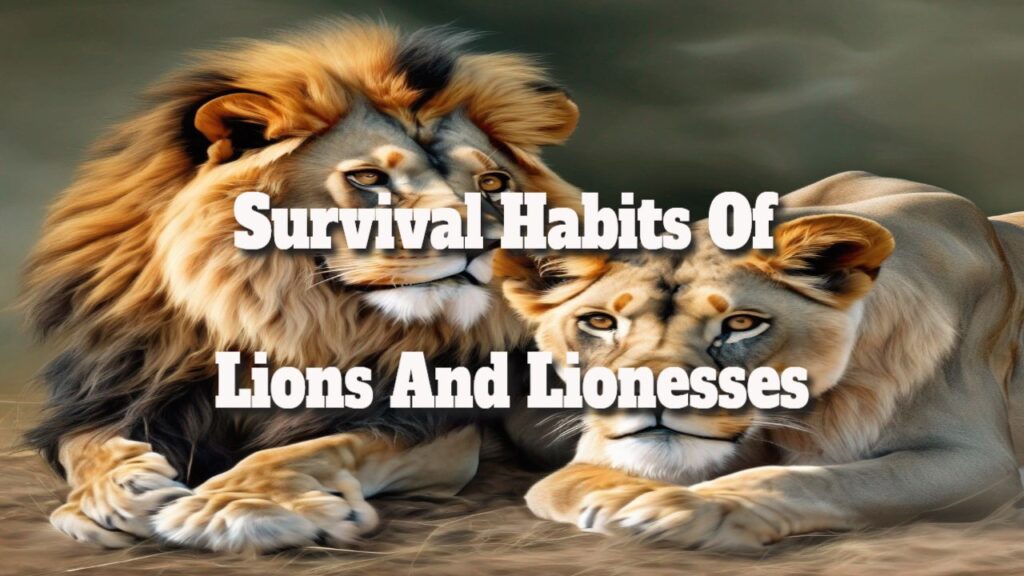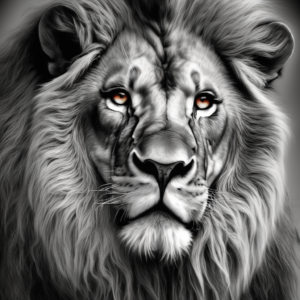Survival Habits of Lions and Lionesses
Lions and lionesses are among the most fascinating animals in the world. These majestic creatures are known for their strength, courage, and hunting skills. However, many people need to learn that lions and lionesses also possess a variety of survival habits that help them thrive in the wild.
One of the most essential survival habits of lions and lionesses is their ability to work together in groups. Prides of lions consist of multiple mothers with their young and a small number of males. Lions are highly gregarious creatures. Each lioness has a specific role within the pride, and they work together to hunt, protect their territory, and raise their young. This teamwork is essential for their survival, allowing them to take down larger prey and defend against predators.
Another survival habit of lions and lionesses is their adaptability. These animals can thrive in various environments, from grasslands to deserts to forests. They can also adapt their hunting strategies based on prey availability. For example, they may switch to hunting smaller animals or scavenging for food if their usual prey is scarce. Their ability to adjust to new conditions is critical to their natural longevity.
Social Structure of Lion Prides
Lions are gregarious felines that form tight-knit prides. The typical pride composition includes many mothers with their young and one or two males. In this section, we will discuss the social structure of lion pride and the roles that lionesses and males play in them.
Roles of Lionesses
The pride’s primary hunters are the lionesses. They work together to stalk and take down prey, which they then share with the rest of the pride. Additionally, they take good care of the cubs, shielding them from harm and instructing them in hunting techniques. Lionesses are highly social animals and form strong bonds with each other, often grooming and playing together.
Hierarchy Among Males
Male lions play a different role in the pride. They keep rival males away from the pride area and ensure the safety of the mothers and their young. They also mate with the females, ensuring the pride’s genetic line continues. However, not all males are equal in the pride. There is a strict hierarchy among males, with the most vital and dominant male, the “alpha male,” at the top. The alpha male has first access to food and mating opportunities, and he is the one who leads the pride in hunts and other activities.
Overall, the social structure of lion prides is complex and highly organized. Every member of the pride has a distinct function, and they work together to ensure the survival and success of the group.
Hunting Techniques and Prey
Team Hunting Strategies
The lion’s remarkable hunting abilities have made it famous, primarily when they work together as a team. Prides are hunting groups that lions form, often including multiple females, their cubs, and maybe a few males. The females are the primary hunters, while the males protect the pride and the territory.
When hunting, lions use a variety of strategies to catch their prey. One of the most common techniques is to surround the prey and attack from different angles, using their strength and sharp claws to take down the animal. This is particularly effective when hunting larger prey such as buffalo or zebras.
Another hunting strategy lions use is to work together to tire out their prey. The lions chase the animal, forcing it to run in circles until it becomes exhausted and can no longer run. At this point, the lions move in for the kill.
Stalking and Ambush Tactics
In addition to team hunting strategies, lions use stalking and ambush tactics to catch their prey. This involves silently approaching the prey behind cover, such as tall grass or bushes, and then pouncing on it when it least expects. This is particularly effective when hunting smaller prey such as gazelles or impalas.
Lions are also known for their patience when hunting. They can spend hours waiting for the perfect opportunity to strike, often waiting for their prey to come to them. This requires great patience and stealth, as any noise or movement can alert the prey and cause it to flee.
Overall, lions are highly skilled hunters with various techniques at their disposal. Their ability to work together as a team and their patience and stealth when hunting makes them one of the most successful predators in the animal kingdom.
Territorial Behaviour and Habitat
Marking and Defending Territory
Lions are known for their territorial behaviour. A pride of lions will defend their territory against other prides and predators. They mark their territory by urinating, rubbing their scent glands, and roaring. The scent marks and roars serve as a warning to other lions to stay away.
Lionesses are responsible for marking and defending the territory. They patrol the boundaries of the territory and mark it with their scent. Lionesses will also defend their territory against predators like hyenas and leopards.
Adaptation to Environments
Lions are adaptable animals; they do well in various habitats, from grasslands and savannas to forests. They can adapt to different environments by changing their hunting and social behaviour.
In areas with dense vegetation, lions will hunt in small groups and use the cover of vegetation to ambush their prey. In open grasslands, they will hunt in larger groups and use their speed and stamina to chase down their prey.
Overall, territorial behaviour and adaptation to different environments are important survival habits for lions and lionesses. They can thrive in the wild by marking and defending their territory and adapting to different environments.
Reproduction and Cub Rearing
Mating Rituals
Lions and lionesses are polygamous, meaning that they mate with multiple partners. The mating season for lions is typically between August and November, during which lionesses will come into estrus for four to six days. During this time, lionesses will mate with multiple males, increasing the chances of a successful pregnancy.
Male lions will compete to mate with a lioness, often engaging in fierce battles that can result in injury or death. The victorious male will mate with the lioness repeatedly over several days.
Cub Survival Skills
Once cubs are born, lionesses take on the primary responsibility of rearing them. Babies, which weigh just about three pounds, are born blind and defenceless. They are entirely dependent on their mother for food and protection.
Lionesses typically give birth to a litter of two to four cubs and will nurse them for six months. During this time, lionesses will teach their cubs essential survival skills, such as hunting and socializing with other lions.
As the cubs age, they accompany their mother on hunts, learning to stalk and take down prey. Lionesses will also teach their cubs how to interact with other lions and defend themselves against potential threats.
Overall, lion cubs’ survival largely depends on the care and guidance provided by their mother. Through careful nurturing and teaching, lionesses ensure their cubs have the skills to survive and thrive in the wild.
Conservation Status and Threats
Human-Wildlife Conflict
Lions and lionesses face numerous threats from humans, including habitat loss, poaching, and retaliatory killing due to conflict with humans and livestock. Conflicts between humans and lions are rising due to the expansion of human populations and their encroachment on lion areas. Farmers may kill lions to protect their livestock, and lions may attack humans in retaliation for habitat loss and hunting.
Conservation Efforts
Various conservation efforts have been implemented to combat these threats to protect lion populations. One such effort is establishing protected areas, such as national parks and reserves, which provide safe habitats for lions to thrive. Additionally, anti-poaching measures have been put in place to deter poachers from killing lions for their valuable body parts.
Lions and people can live peacefully if conservation groups and locals work together. This includes providing education and resources to help farmers protect their livestock without resorting to killing lions and implementing measures to reduce human-lion conflict, such as building physical barriers and using deterrents.
While lions and lionesses face significant threats from human activity, these gorgeous creatures are the subject of continuing conservation efforts to safeguard them for future generations.
The post Survival Habits of Lions and Lionesses appeared first on https://gqcentral.co.uk





Comments are closed